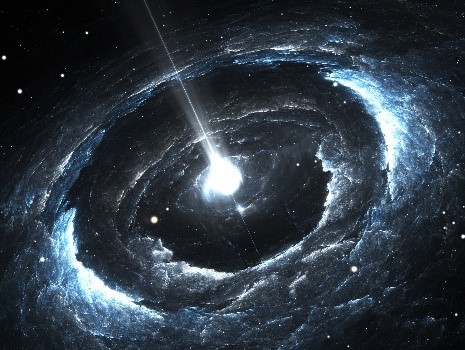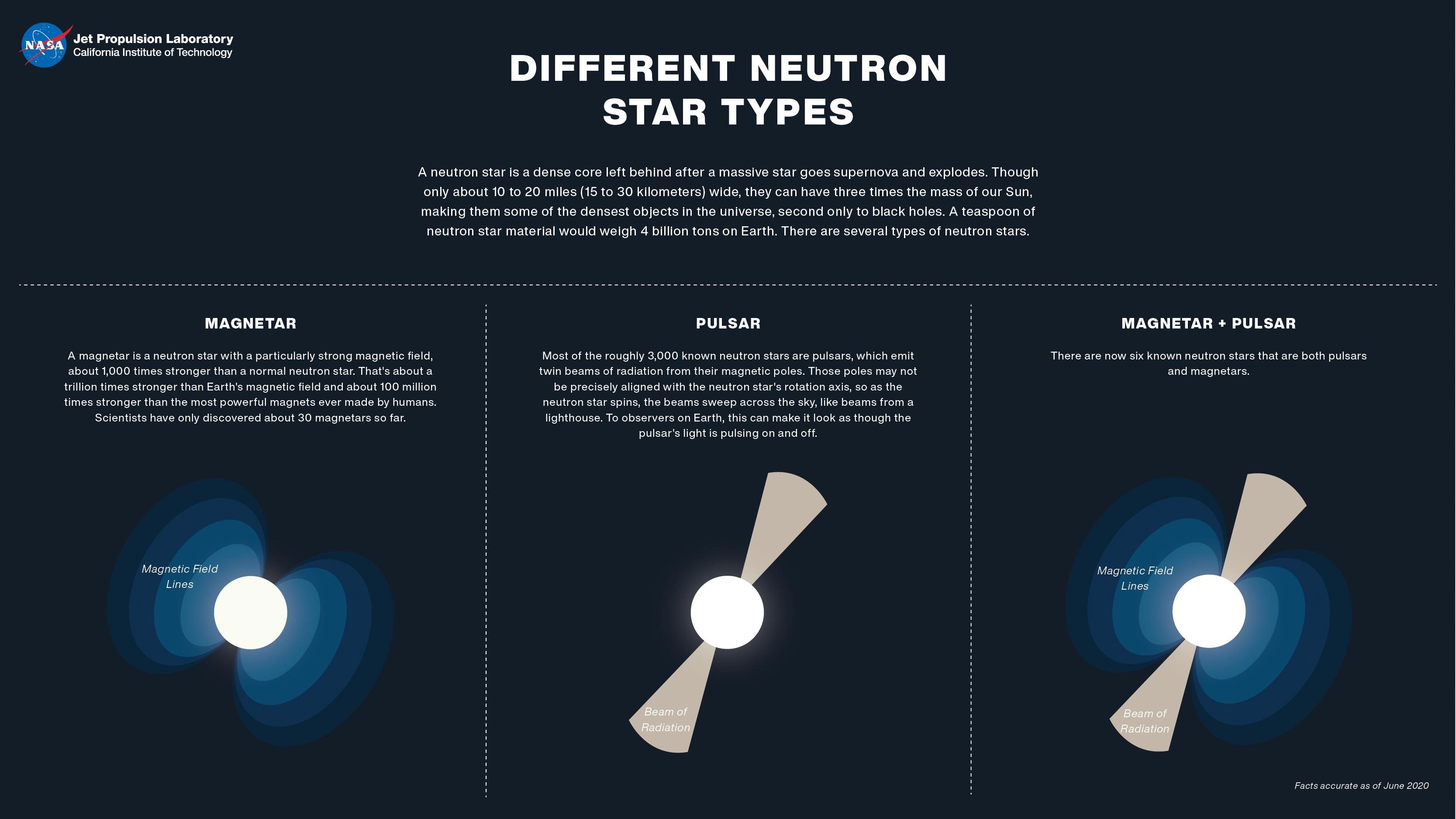Description

Disclaimer: Copyright infringement not intended.
Context:
- Data from NASA's Fermi Gamma-ray Space Telescope has been used by scientists to discover the first gamma-ray eclipses from a special type of binary star system called Spider system.
Background: Pulsars & Neutron Stars:
- A pulsar is formed when a massive star collapses exhausts its supply of fuel.
- It blasts out in a giant explosion known as a supernova, the most powerful and violent event in the universe.
- Without the opposing force of nuclear fusion to balance it, gravity begins to pull the mass of the star inward until it implodes.
- In a pulsar, gravity compacts the mass of the star until it forms an object composed primarily of neutrons packed so tightly that they no longer exist as normal matter.
- Now, this neutron star continues to shed energy through energetic beams, and if the star is oriented just right, one of those beams will sweep across our field of view on Earth and appear to “pulse” at regular intervals.
- A physicist named Chandrasekhar Subrahmanyan theorized that if the mass of the core of the collapsing star was 1.4 times the mass of the star itself, the protons and electrons would combine to form neutrons in a neutron star. This number is known today as the Chandrasekhar limit.
- If this limit is not achieved by the collapsing core, a white dwarf star will be produced instead.
- If the limit is much greater, a black hole may be the result.
- As the star collapses, it begins to spin more rapidly in what is known as the conservation of angular momentum. What is left behind is a rapidly spinning ball of tightly packed neutrons inside an iron shell. The extreme force of gravity would cause this shell to be extremely smooth and shiny. The resulting neutron star is only about 20 miles in diameter, yet it contains most of the mass of the original star it was formed from. The matter in this neutron star is packed so tightly that a piece the size of a sugar cube would weigh over 100 million tons on Earth.
.jpeg)
Emission from Pulsar Star:
- A pulsar is a highly magnetized rotating neutron star that emits of electromagnetic radiation out of its magnetic poles.
- This radiation can be observed only when a beam of emission is pointing toward Earth (similar to the way a lighthouse can be seen only when the light is pointed in the direction of an observer), and is responsible for the pulsed appearance of emission.

- Neutron stars are very dense and have short, regular rotational periods. This produces a very precise interval between pulses that ranges from milliseconds to seconds for an individual pulsar. Pulsars are one of the candidates for the source of ultra-high-energy cosmic rays
Spider Star Systems:
- These so-called spider systems contain a pulsar – the superdense, rapidly rotating remains of a star that exploded in a supernova – that slowly erodes its companion star.
- These never-seen gamma-ray eclipses are caused by the low-mass companion star of the pulsar moving in front of it and very briefly blocking high-energy photons.
- Scientists have found seven spiders that undergo these eclipses, which occur when the low-mass companion star passes in front of the pulsar from our point of view.
- One of the most important goals for studying spiders is to try to measure the masses of the pulsars.
Mechanism:
- Spider systems develop because one star in a binary evolves more swiftly than its partner. When the more massive star goes supernova, it leaves behind a pulsar. This stellar remnant emits beams of multiwavelength light, including gamma rays, that sweep in and out of our view, creating pulses.
- Early on, a spider pulsar feeds off its companion by siphoning away a stream of gas. As the system evolves, the feeding stops as the pulsar begins to spin more rapidly, generating particle outflows and radiation that superheat the companion's facing side and erode it.
- Scientists divide spider systems into two types named after spider species whose females sometimes eat their smaller mates. Black widows contain companions with less than 5 percent of the Sun's mass. Redback systems host bigger companions, both in size and mass, weighing between 10 percent and 50 percent of the Sun.
- Researchers can calculate the masses of spider systems by measuring their orbital motions. Visible light observations can measure how quickly the companion is traveling, while radio measurements reveal the pulsar's speed. However, these rely on motion towards and away from us- the Earth. The same signals also could be produced by a smaller, slower-orbiting system that's seen from the side of the Earth. Thus, knowing the spider system's tilt relative to our line of sight is vital for measuring mass.
- The tilt's angle is normally measured using visible light, but these measurements again come with some potential complications due to debris/fluctuation in visible light due to change in superheated side.
- Gamma rays, however, are only generated by the pulsar and have so much energy that they travel in a straight line, unaffected by debris, unless blocked by the companion. If gamma rays disappear from the data set of a spider system, scientists can infer that the companion eclipsed the pulsar. From there, they can calculate the system's tilt into our sight line, the stars' velocities, and the pulsar's mas.
TRIVIA


https://www.space.com/spider-system-pulsar-gamma-ray-eclipses
https://tech.hindustantimes.com/tech/news/nasa-discovers-first-gamma-ray-eclipses-from-spider-star-systems-71674817536573.html

















